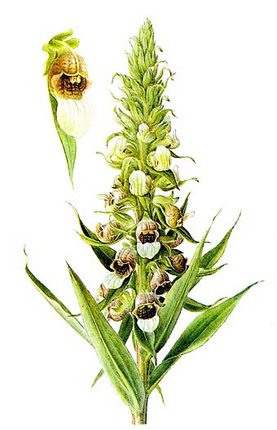Foxglove sherstystaya – Digitalis lanata Ehrh.
Perennial or biennial herbaceous plant 60-80 cm, families norichnikovыh (Scrophulariaceae). In wild-growing form is found in the Mediterranean countries.

The chemical composition of digitalis woolly
Grass woolly foxglove contain cardiac glycosides (digilanidы, or lanatosides A, B, C, D, IS, digitoxine, digoxin and others.), steroidal glycosides (digitonin and tigonin), organic acids and other compounds.
Specific biological activity of cardiac glycosides digitalis woolly believe lanatozid C and digoxin, wherein lanatozid C during the hydrolysis proceeds in digoxin.
The pharmacological properties of woolly foxglove
Of all the individual woolly digitalis glycosides medicine used lanatozid With (celanid) and digoxin.
Tselanid refers to quick and cardiac glycosides, like strofantinu, It has a short latency period. The effect after intravenous administration is already manifested in 15-30 minutes and reaches its maximum usually after 1,5 - 2 no. If oral administration of the drug action begins 2 hours and reaches a maximum after 5-6 h.
Of all digitalis glycosides tselanid has the least ability to cumulation, because the drug binds to a little serum proteins and quickly excreted from the body. Eliminating it during the day is about 20 % of the administered dose. The duration of the effect of the same tselanida, as digoxin. Action adopted by the full therapeutic dose stops after 5-8 days after drug withdrawal.
Digoxin has a pronounced effect of systolic. According to phase analysis of cardiac activity under the influence of digoxin is greatly enhanced cardiac contractility. The drug has also a significant effect of diastolic. Diastole under the influence of digoxin becomes longer, heart rate slows, through 24 hours after the start of treatment slows the pulse on average 17 %, and through 48 h - of 36 %. Like all drugs woolly foxglove, Digoxin has a significant diuretic effect.
The drug belongs to a fast cardiac glycosides with a short latency period. His influence is manifested through 15-30 min after injection into a vein, then gradually increases, peaking through 2 no, then gradually decreases, ceasing entirely by the end of the first day.
The drug is well absorbed. This allows its use also orally. If ingestion is absorbed 50-70 % amount received. The action of digoxin in the pen- eral administration manifested through 2 hours and reaches a maximum 6 no.
The drug is relatively rapidly excreted from the body. The daily elimination of it is about 15-25% of the injected amount. From digitoxin digoxin differs considerably less pronounced cumulative properties, faster and shorter duration of action. The speed of the therapeutic effect of digoxin reminds strophanthin-K; however, it is highly effective when administered orally and, and provides a more pronounced effect vagotropic.
These clinical observations and studies of the coronary blood flow with radioactive krypton show, that digoxin does not affect the coronary blood flow and causes increased frequency of angina attacks.
The use of digitalis woolly medicine
Celanid is prescribed for acute and chronic circulatory failure II and stage III, tachysystolic atrial fibrillation, supraventricular paroxysmal tachycardia form. The drug is prescribed inside, and if necessary, obtain a rapid effect (in acute heart failure, paroxysmal tachycardia, in severe forms of chronic circulatory failure with the stagnation in the gastrointestinal tract, interfere with the absorption of the drug) injected.
Digoxin administered orally or intravenously (in severe circulatory disorders).
With an overdose of digoxin may experience nausea, vomiting, ʙigeminija, tachycardia. Toxic effects due to the low accumulation of the drug usually disappear in 24-48 hours after its cancellation.
Contraindications to the appointment tselanida and digoxin are the same, for other digitalis glycosides.
Formulations, Method of application and doses of digitalis
Digoxin (Digoxin) - Glycoside, derived from primary glycoside digitalis woolly lanatozida With. The white crystalline powder, practically insoluble in water, slightly soluble in alcohol.
Digoxin is administered orally and intravenously cupping paroksizmalyyuy tachycardia and severe circulatory disorders. The initial dose is 0.5-1 mg (2-4 Ml 0,025 % solution). Intravenous digoxin is introduced slowly, 3-5 min, 10-20 ml 20 % or 40 % glucose solution or isotonic sodium chloride solution. Re-injection of digoxin is possible after 6-8 hours. The maximum daily dose when administered intravenously 1,5 mg (6 ml 0,025 % solution).
When administered in a daily dose of 1 day is 1,25 mg (5 tablets 0,25 mg), 2 day - 5 tablets and third day - 3 tablets. Dose make daily, taking into account the performance of pulse, respiration and diuresis. Depending on the effect of repeated dose or gradually reduced. After reaching the required transition effect for treatment maintenance doses: 0,250.5 mg. Such treatment should be applied in the case, if the doctor can monitor the patient before prescribing each dose. If you have to be afraid of unexpected toxic effects in the appointment of relatively small doses, It recommended in the first 3-4 days to give the patient at 0,75 mg digoxin, and then transfer it to the maintenance doses of.
Celanid (Сеlanidum) -genuinny glycoside from the leaves of digitalis woolly. Colourless or white crystalline powder. Very slightly soluble in water, it is difficult - in alcohol.
Assign inside of 0,25 mg 2-3 times a day; intravenously, 1-2 ml 0,02 % solution 1-2 times a day.
When paroksizmalyyuy tachycardia intravenous 0,8 mg (4 ml 0,02 % solution). If an hour attack is not stopped, reinjected 0,4 mg. The outpatient use tselanid 0.5-1 mg per day for a long time.
Higher doses for adults inside: single 0,0005 g (0,5 mg), daily 0,001 g (1 mg); a vein: single 0,0004 g (0,4 mg), daily 0,0008 g (0,8 mg). Available in tablets 0,25 mg in ampoules 1 ml 0,02 % solution (1:5000).
